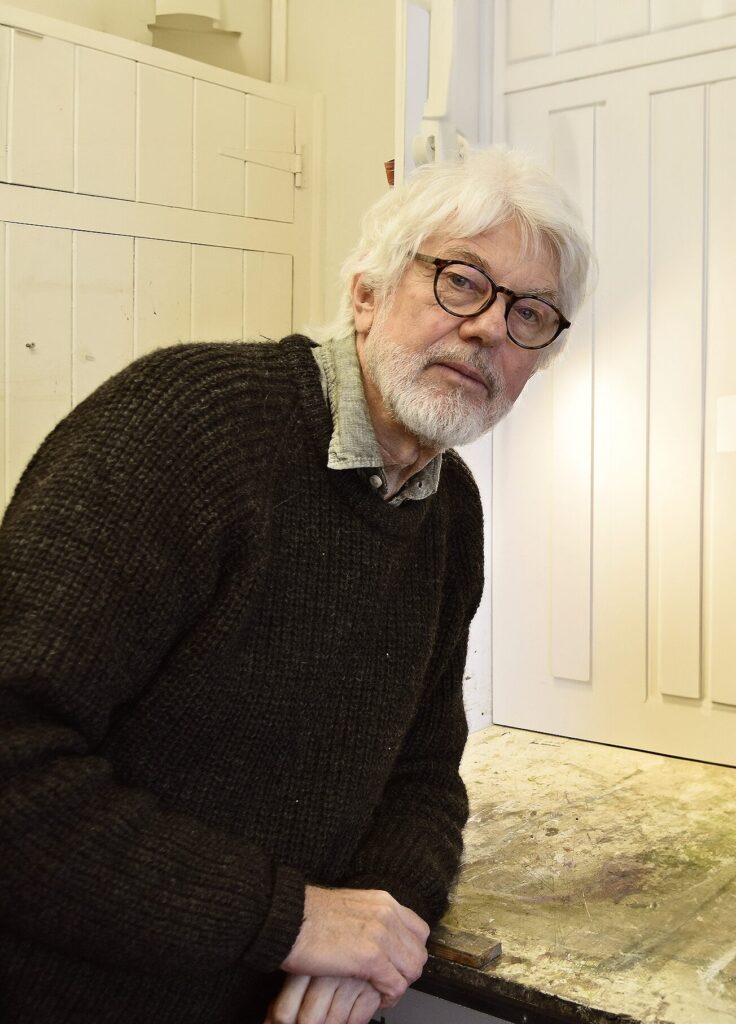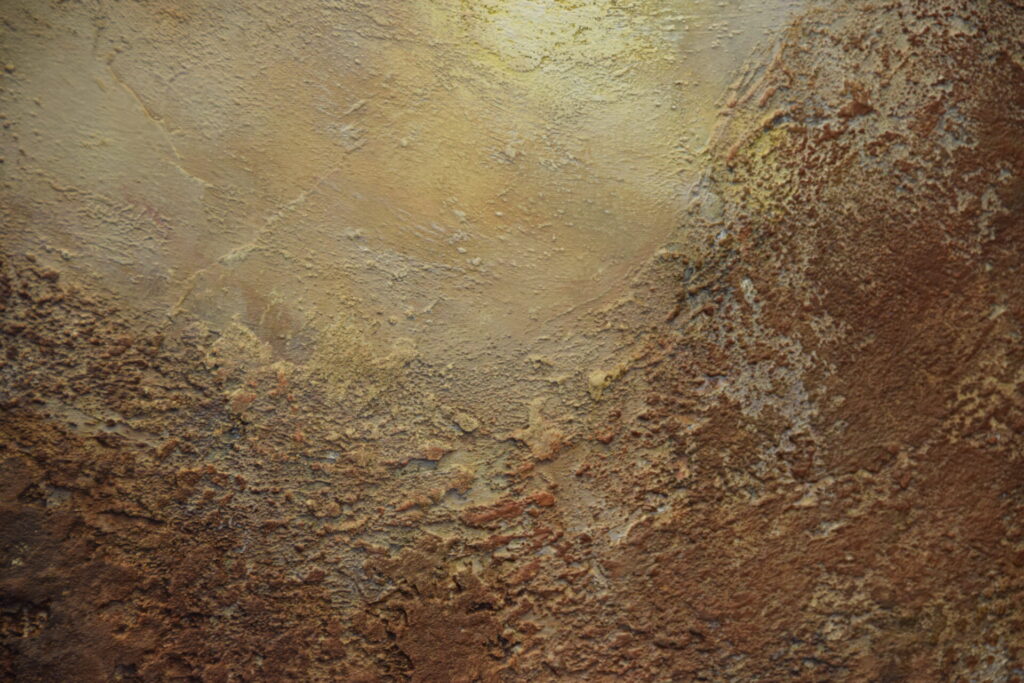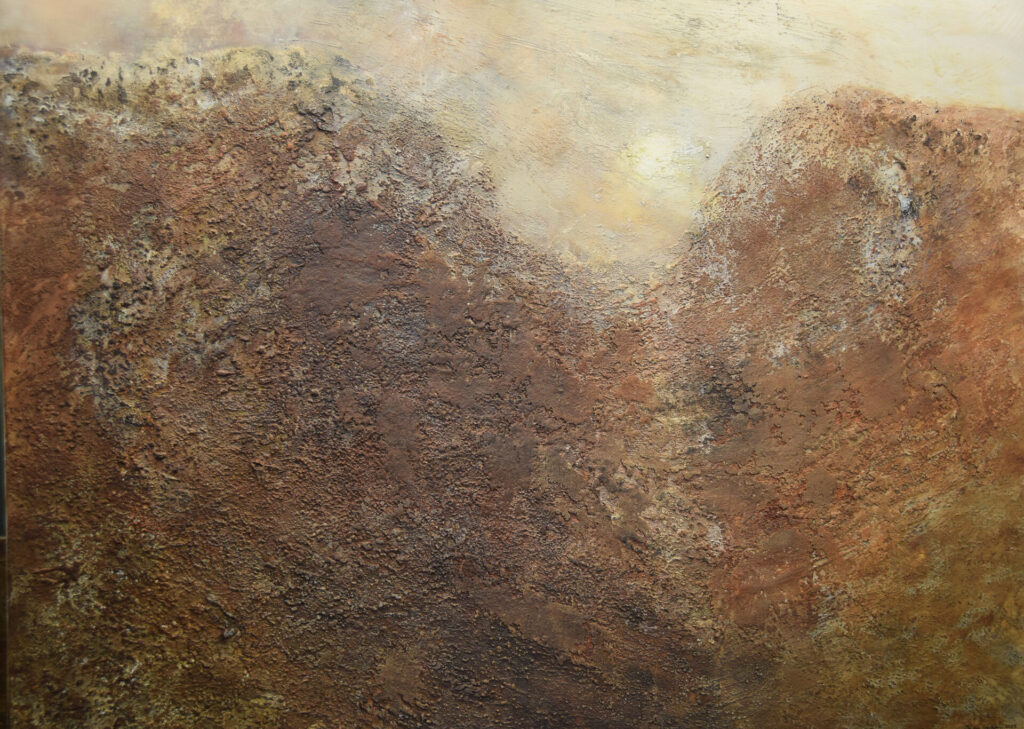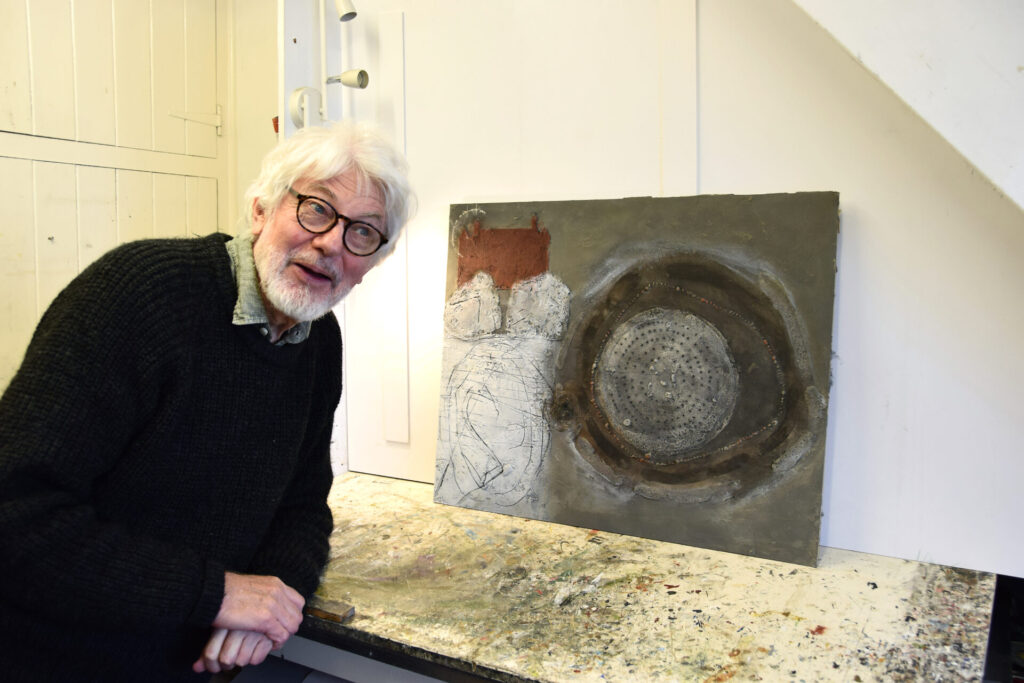Brian Graham explores deep time in his mesmerising abstract paintings – from prehistoric music-making to Thomas Hardy’s Great Heath

The pictures shown here are all recent work in his studio, and give some idea of his techniques and use of textures – and his impish sense of humour!
All images: Gay Pirrie-Weir
We dig for the gods that leave no bones*
There is a line in a song by Johnny Flynn and Robert Macfarlane that comes to mind when you look into Brian Graham’s deep and mysterious paintings. Often inspired by archaeological discoveries, palaeontology, burial sites and the marks that our Neolithic forebears made on the cliffs and caves where they lived, the Purbeck artist finds his source material not only in visits to ancient sites, but in his reading and in conversations with archaeologists, palaeontologists, historians and philosophers.
In the introduction to Starting from Scratch, a 2011 exhibition at the Hart Gallery in London, he writes about the impact of Homo Britannicus, a 2006 book by Chris Stringer who outlined what was then known about our earliest ancestors. The latest research indicated that Britain was occupied by ancient beings, possibly as far back as 950,000 years.

‘It taxes the imagination to contemplate these nearly one million-year-old pioneering peoples and their unrelenting struggle for survival,’ says Brian. ‘In order to acknowledge their tenacity, bravery and ambition, I felt compelled to pay homage to the vestiges of their achievements, in a series of representations that look at the evolutionary marks they have tantalisingly left behind.’
His researches and visits to many locations including chalk and gravel pits, beautiful landscapes, contemporary business parks, railway stations, eroding cliff faces and even an adventure park, were ‘profoundly moving.’
The sort of challenges these early peoples encountered is shown in the powerful Starting from Scratch series of paintings, such as Stoneham’s Pit, Crayford, Kent. Brian says: ‘A period of severe cold was looming, signalled by the skeletal remains of mammals large and small: muskox, lemmings and ground squirrels. Early Neanderthals stood their ground for a while – beautiful prepared core flint flakes were found in close proximity to woolly rhinoceros jaws.’

Making music
A few years later, Brian’s ever-inquiring artist’s imagination drew him to music – and to the way our ancient forebears may have made it. The result of these researches, journeys and explorations was Towards Music, a memorable exhibition at the gallery of The Salisbury Museum in the Cathedral Close in 2018. Brian loves music and his wide tastes and knowledge are evident in the sources, titles and themes of these 40 equally-sized, painted reliefs – Miles Davis, Shostakovich, Evelyn Glennie, Ravel, Satie, Bach, the dancer Sylvie Guillem … names that for a music lover instantly evoke passion, discipline, rhythm and music-making.
In even the earliest peoples, the drive to create seems to have been irresistibly strong. Cave paintings in France, often hundreds of yards into caverns or deep underground, show the efforts that people made to paint things they knew, in places where they had to make some form of light by which to work, as well as making the materials with which they painted or carved their subjects.
Some of the oldest – the lions and rhinos of the Chauvet Cave in south eastern France – are thought to be around 30,000 to 32,000 years old. In Ireland, the detailed carvings on the kerbstones around the massive Knowth burial mound and its neighbour, the even more spectacular Newgrange, with its winter solstice sunrise light path 25 yards into the centre, were made around 5,000 years ago and are older than Stonehenge.
Music making, singing and instruments are frequently shown in paintings from medieval times – they have helped to inform much of the early music movement, which has sought to recreate both the vocal and instrumental sounds of past centuries.
The themes and textures in Brian’s paintings reflect this evidence of our prehistoric ancestors’ drive to create.

The Great Heath
It is not just ancient people and their music, art and struggle for life that inspire Brian Graham. Living in Dorset all his life, he is also deeply engaged with its dramatic geology and coastline, and the landscapes that are such an integral part of Thomas Hardy’s writing, particularly the Great Heath – Hardy’s Egdon Heath, which is almost a character in its own right in The Return of the Native.
This was the theme of Brian’s 2019 exhibition at Sladers Yard, West Bay, which drew particularly on his own childhood memories of time spent on the heath, which once covered so much of East Dorset. This particular landscape was mostly created during the Bronze Age, he says, citing the large number of tumuli across the area, but the story goes back much further – the former river Solent meandered across the sandy heath and material found indicates human occupation for perhaps 500,000 years.
Music and landscape meet here with literature and art – Thomas Hardy described the heath to Gustav Holst as “a vague stretch of remoteness” and the composer responded with a melancholy tone poem, Egdon Heath, which he considered his masterpiece (though it is less-known than the much-loved Planets suite).
As well as this vast back story and his own childhood memories, Brian was able to draw on a memorable and rare personal experience – driving back across Wareham Heath his headlights picked up “a spectral aerial ballet of whirring intensity” … it was a nightjar, that most elusive of all the UK’s nocturnal birds.
Major collections
Brian was born in Poole in 1945 and, throughout his life, has lived and worked in Dorset, where the ancient geology and dramatic coastline have long been an inspiration.
He had his first exhibition in 1979 and soon became known for his powerful and heavily textured paintings. In 1992, he won first prize at the Royal West of England Academy annual autumn exhibition, and he was chosen as the first Bournemouth International Festival Artist.
Until it closed, he was for many years represented by London’s Hart Gallery, who brought his work to international attention at major art fairs including Glasgow, Nimes and Geneva.
He has work in many national and private collections, including the Natural History Museum, which has his large portfolio project, The Book of Boxgrove.
He has worked across genres with archeologists, writers, Dorset poet Paul Hyland, and in 2013, the North Dorset composer Sadie Harrison wrote Hidden Ceremonies 1: 9 Fragments after paintings by Brian Graham, for solo piano.
I first encountered Brian Graham’s paintings more than 40 years ago at an exhibition in Bournemouth – I am often drawn to abstract landscapes. I find the artist’s response to that indefinable sense of place can often be better conveyed in texture, layers and shades of natural forms and colours, rather than a figurative representation. You respond differently to the abstract landscape because it is porous to your own memories and imagination – FC
*The quote is a line from Coins for the Eyes, which is used as the theme music for Professor Alice Roberts’ television series, Digging for Britain. The song is included on the 2023 album The Moon Also Rises, with music by Johnny Flynn and lyrics by writer, poet and naturalist Robert Macfarlane.



